Nature of sound and its propagation in various media, speed of sound,
- Books Name
- Science Made Easy Science Book
- Publication
- Science Made Easy
- Course
- CBSE Class 9
- Subject
- Science
Introduction
→ The sensation felt by our ears is called sound.
→ Sound is a form of energy which makes us hear.
→ Law of conservation of energy is also applicable to sound.
→ Sound travels in form of wave.
Production of Sound
→ Sound is produced when object vibrates or sound is produced by vibrating objects.
→ The energy required to make an object vibrate and produce sound is provided by some out
source (like our hand, wind etc.).
→ Example: Sound of our voice is produced by vibration of two vocal cords in our throat.
• Sound of a drum or tabla is produced by vibration of its membrane
when struck.
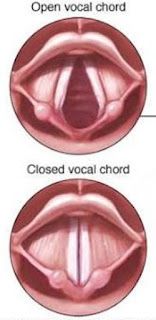
→ In laboratory experiments, sound is produced by vibrating tuning fork. The vibrations of tuning fork
can be shown by touching a small suspended pith ball (cork ball) with a prong of the sounding
tuning fork. The pith ball is pushed away with a great force.
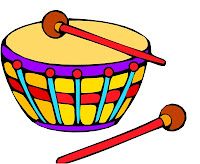
→ In laboratory experiments, sound is produced by vibrating tuning fork. The vibrations of tuning fork
can be shown by touching a small suspended pith ball (cork ball) with a prong of the sounding
tuning fork. The pith ball is pushed away with a great force.
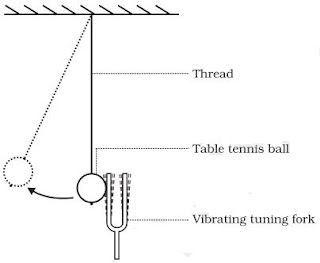
• Sound can be produced by following methods:
(i) By vibrating string (sitar)
(ii) By vibrating air (flute)
(iii) By vibrating membrane (table, drum)
(iv) By vibrating plates (bicycle bell)
(v) By friction in objects
(vi) By scratching or scrubbing the objects etc.
Propogation of Sound
→ The substance through which sound travels is called a medium.
→ The medium may be solid, liquid or gas.
→ When an object vibrates, then the air particles around it also start vibrating in exactly the same
way and displaced from their stable position.
→ These vibrating air particles exert a force on nearby air particles so they are also displaced from
their rest position and start to vibrate.
→ This process is continued in the medium till sound reaches our ears.
→ The disturbance produced by sound travels through the medium (not the particles of the
medium).
→ Wave is a disturbance which travels through a medium and carries energy.
→ So sound travels in wave form known as mechanical waves.

• When a body vibrates then it compresses the air surrounding it and form a area of high density
called compression (C).
→ Compression is the part of wave in which particles of the medium are closer to one another
forming high pressure.
→ This compression move away from the vibrating body.
• When vibrating body vibrates back a area of low pressure is formed called rarefaction (R).
→ Rarefaction is the area of wave in which particles of the medium are further apart from one
another forming a low pressure or low density area.
→ When body vibrates back and forth, a series of compression and rarefaction is formed in air
resulting in sound wave.
→ Propogation of sound wave is propogation of density change.
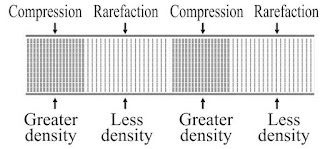
Sound needs Medium for Propogation
• Sound waves are mechanical waves.
→ It needs material medium for propogation like air, water, steel etc.
→ It cannot travel in vaccum.
→ An electric bell is suspended in airtight bell jar connected with vacuum pump.
→ So, medium is necessary for propagation of sound.
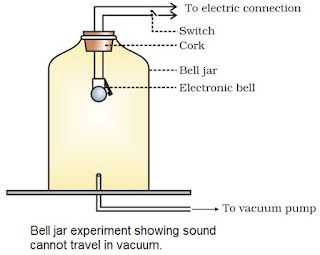
Experiment to show that sound cannot travel through vacuum
Sound Waves as Longitudinal Waves
• A wave in which the particles of the medium vibrate back and forth in the same direction in which
the wave is moving, is called a longitudinal wave.
→ When we push and pull the slinky compression (number of turns are more or closer) and
rarefaction (number of turns are less or farther) are formed.
→ When a wave travels along with slinky, its each turn moves back and forth by only a small
distance in the direction of wave. So the wave is longitudinal.
→ The direction of vibrations of the particles is parallel to the direction of wave.

• When one end of a slinky is moved up and down rapidly whose other end is fixed, it produces
transverse wave.
→ This wave possess along the slinky in horizontal direction, while turns of slinky (particles) vibrates
up and down at right angle to the direction of wave.
→ Thus in transverse wave particles of the medium vibrate up and down at right angles to the
direction of wave.
→ Light waves are transverse waves but they don’t need a material

Characteristics of Sound Wave
• The characteristics of sound waves are : wavelength, frequency, amplitude, time period and
velocity.
→ When a wave travel in air the density and pressure of air changes from their mean position.
→ Compression is shown by crest while rarefaction is shown by trough.
→ Compression is the region of maximum density or pressure.
→ Rarefaction is the region of minimum density or pressure.
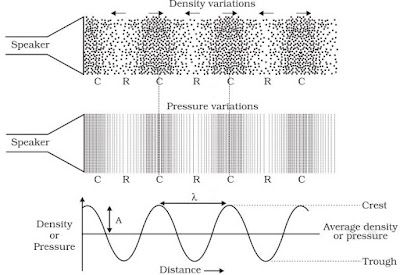
Wavelength
→ In sound waves the combined length of a compression and an adjacent rarefaction is called
wavelength.
→ The distance between the centres of two consecutive compressions or two consecutive
rarefactions is also called its wavelength.
→ It is denoted by the Greek letter lamda (λ). Its SI unit is metre.
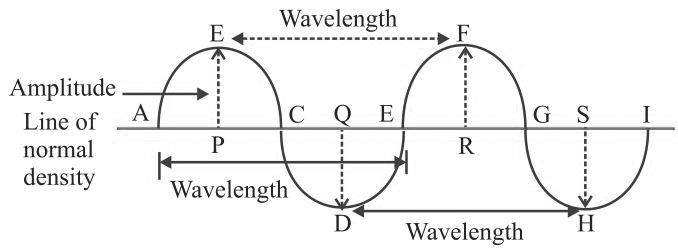
Frequency
→ No. of complete waves produced in one second or number of vibrations per second is called
frequency.
→ Number of compressions or rarefactions passed in one second is also frequency.
→ Frequency of wave is same as the frequency of the vibrating body which produces the wave
• The SI unit of frequency is hertz (Hz). The symbol of frequency is v (nu).
• 1 Hertz: One Hz is equal to 1 vibration per second.
• Bigger unit of frequency is kilohertz kHz = 1000 Hz.
Time Period
→ Time taken to complete one vibration is called time period.
→ Time required to pass two consecutive compressions or rarefactions through a point is called
time period.
• SI unit of time period is second (s). Time period is denoted by T.
• The frequency of a wave is the reciprocal of the time period.
• v = 1/T
Amplitude
→ The maximum displacement of the particle of the medium from their original undisturbed
position is called amplitude of the wave.
• Amplitude is denoted by A and its SI unit is metre (m).
→ Sound have characteristics like pitch and loudness and timbre.
• Pitch: The pitch of sound depends on the frequency of sound (vibration).
→ It is directly proportional to its frequency. Greater the frequency, higher is the pitch and lesser the
frequency, lower is the pitch.
→ A woman’s voice is shrill having a high pitch while a man’s voice is flat having low pitch.
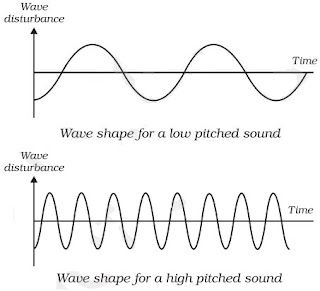
• Loudness: The loudness depends on the amplitude of the sound wave.
→ Loudness is the measure of the sound energy reaching the ear per sec.
→ Greater the amplitude of sound wave, greater is the energy, louder the sound; short is the
amplitude, less is the energy, soft is the sound.
→ Loudness is measured in decibel ‘dB’.
• Quality or Timbre: The timbre of a sound depends on the shape of sound wave produced by
the characteristic of musical sound.
→ It helps us to distinguish between two sounds of same pitch & loudness.
• Sound of single (same) frequency is called tone while a mixture of different frequencies is called
note.
• The distance travelled by a wave in one second is called velocity of the wave.
• Its SI unit is metre per second (m/s ).
Velocity = Distance travelled/Time taken
⇒ v = λ/T
(λ is the wavelength of the waves travelled in one time time period T)
v = λv (1/T = v)
So, Velocity = Wavelength × Frequency
This is the wave equation.
Example: What is the frequency of sound wave whose time period is 0.05 second ?
Speed of Sound in Various Mediums
→ Speed of sound depends on the nature of material through which it travels. It is slowest in gases,
faster in liquids and fastest in solids.
→ Speed of sound increases with the rise in temperature.
→ Speed of sound increases as humidity of air increases.
→ Speed of light is faster than speed of sound.
→ In air, speed of sound is 344 ms -1 at 22ºC.
Sonic Boom
→ Some aircrafts, bullets, rockets etc. have ‘supersonic speed’.
• Supersonic refers to the speed of an object which is greater than the speed of sound and it
produces extremely loud sound waves called ‘shock waves’ in air.
range of hearing in humans
- Books Name
- Science Made Easy Science Book
- Publication
- Science Made Easy
- Course
- CBSE Class 9
- Subject
- Science
Range of Hearing
(i) Range of hearing in human is 20 Hz to 20000 Hz.
→ Children younger than 5 years and dogs can hear upto 25 Khz.
(ii) The sounds of frequencies lower than 20 Hz are
known as ‘infrasonic sounds’
→ A vibrating simple pendulum produces infrasonic sounds.
→ Rhinoceroses communicate each other using frequencies as low as 5 Hz.
→ Elephants and whales produces infrasonic waves.
→ Earthquakes produces infrasonic waves (before shock waves)
which some animals can hear and get disturbed.
(iii) The sounds of frequencies higher than 20 KHz are known as ‘ultrasonic waves’.
→ Dogs, parpoises, dolphins, bats and rats can hear ultrasonic sounds.
→ Bats and rats can produce ultrasonic sounds.
ultrasound
- Books Name
- Science Made Easy Science Book
- Publication
- Science Made Easy
- Course
- CBSE Class 9
- Subject
- Science
Applications of Ultrasound
(i) It is used to detect cracks in metal blocks in industries without damaging them.
(ii) It is used in industries to clean ‘hard to reach’ parts of objects such as spiral tubes, odd shaped
machines etc.
(iii) It is used to investigate the internal organs of human body such as liver, gall bladder, kidney
uterus and heart.
(iv) Ecocardiography: These waves are used to reflect the action of heart and its images are
formed. This technique is called echocardiography.
(v) Ultrasonography: The technique of obtaining pictures of internal organs of the body by using
echoes of ultrasound waves is called ultrasonography.
(vi) Ultrasound is used to split tiny stones in kidneys into fine grains.
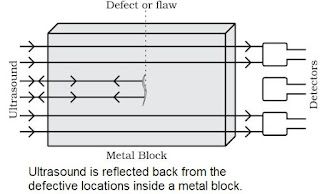
reflection of sound
- Books Name
- Science Made Easy Science Book
- Publication
- Science Made Easy
- Course
- CBSE Class 9
- Subject
- Science
Reflection of Sound
→ Like light, sound also bounce back when it falls on a hard surface. It is called reflection of sound.
• The laws of reflection of light are obeyed during reflection of sound.
(i) The incident sound wave, the reflected sound wave and normal at the point of incidence lie
same plane.
(ii) Angle of reflection of sound is always equal to the angle of incidence of sound.
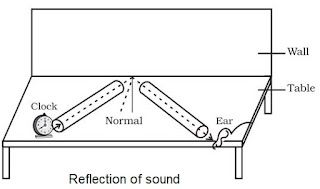
Applications of Reflection of Sound
(i) Megaphone, loudspeakers, bulb horns and trumpets, shehnai etc. are designed to send sound to
a particular direction without spreading all around.
→ All these instruments have funnel tube which reflects sound waves repeatedly towards audio
In this amplitude of sound waves adds up to increase loudness of sound.
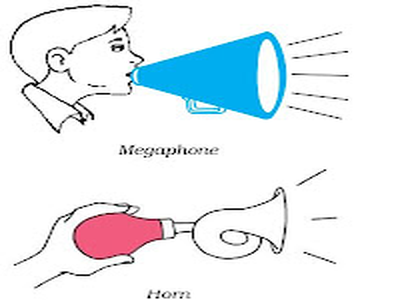
(ii) Stethoscope: It is a medical instrument used for listening the sounds produced in human bo
mainly in heart and lungs. The sound of the heartbeats reaches the doctor’s ears by the multipe
reflection of the sound waves in the rubber tube of stethoscope.

(iii) Sound Board: In big halls or auditoriums sound is absorbed by walls, ceiling, seats etc. So a
curved board (sound board) is placed behind the speakers so that his speech can be heard easily
by audiences. The soundboard works on the multiple reflection of sound.
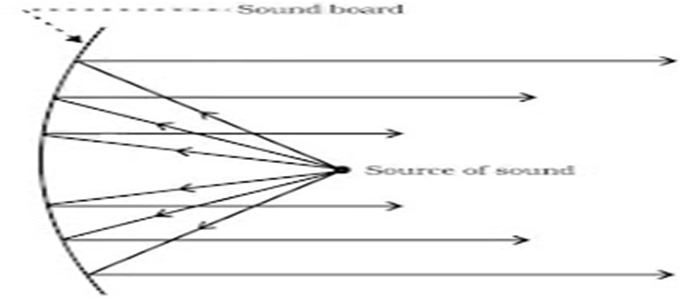
(iv) The ceiling of concert halls are made curved, so that sound after reflection from ceiling, rea
all the parts of the hall.
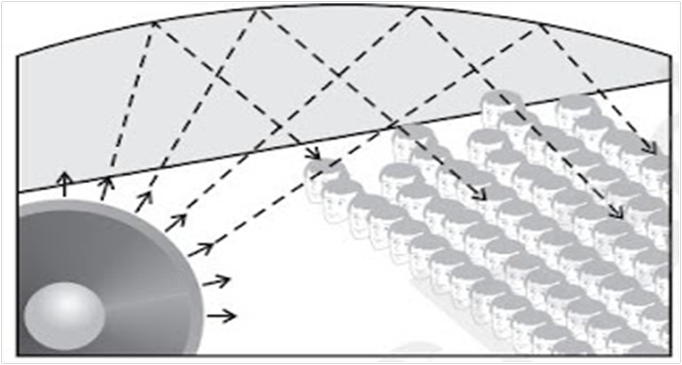
echo and SONAR
- Books Name
- Science Made Easy Science Book
- Publication
- Science Made Easy
- Course
- CBSE Class 9
- Subject
- Science
Echo
• The repetition of sound caused by the reflection of sound waves is called an echo.
→ We can hear echo when there is a time gap of 0.1 second in original sound and echo (reflection of
sound).
→ Echo is produced when sound reflected from a hard surface (i.e. brick wall, mountain etc.) as
surface tends to absorb sound.
Minimum distance to hear an echo
Speed = Distance/Time
Here, Speed of sound in air = 344 ms -1 at 22ºC
Time = 0.1 second
344 = Distance/0.1 sec
⇒ Distance = 344 × 0.1 = 34.4 m
So, distance between reflecting surface and audience = 34.4/2 = 17.2 (at 22ºC).
Reverberation
• The persistence of sound in a big hall due to repeated reflection of sound from the walls, ceiling
and floor of the hall is called reverberation.
→ If reverberation is too long, sound becomes blurred, distorted and confusing due to overlapping
of different sound.
Methods to reduce reverberation in big halls or auditoriums
→ Panels made of felt or compressed fibre board are put on walls and ceiling to absorb sound
→ Heavy curtains are put on doors and windows.
→ Carpets are put on the floor.
→ Seats are made of material having sound absorbing properties.
SONAR
→ The word ‘SONAR’ stands for ‘Sound Navigation And Ranging’.
→ SONAR is a device which is used to find distance, direction and speed of underwater objects
→ SONAR consists of a transmitter and a receptor or detector and installed at the bottom of a sea
→ The transmitter produces and transmits ultrasonic waves.
→ These waves travel through water and after striking the objects on the bottom of sea, are
reflected back and received by detector.
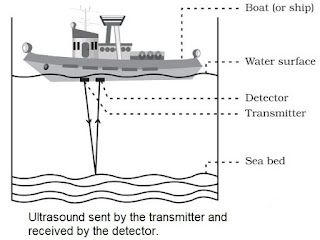
→ These reflected waves are converted into electric signals by detector.
→ The sonar device measures the time taken by ultrasound waves to travel from ship to bottom of
sea and back to ship.
→ Half of this time gives the time taken by the ultrasound waves from ship to bottom.
• Let the time interval between transmission and reception of ultrasound signal is t.
Speed of sound through sea water is v
Total distance travelled by waves = 2d.
→ The sonar is used to find the depth of sea, to locate underwater hills, valleys, submarines, ice
and sunken ships etc.
→ Bats fly in the dark night by emitting high pitched ultrasound waves which are reflected from
obstacle or prey and returned to bats ear.
→ The nature of reflection tells the bat where the obstacle or prey is and what it is like.
Structure of the human ear (auditory aspect only)
- Books Name
- Science Made Easy Science Book
- Publication
- Science Made Easy
- Course
- CBSE Class 9
- Subject
- Science
Structure of The Human Ear
→ The ear consists of three parts: outer ear, middle ear and inner ear.
→ The ears are the sense organs which help us in hearing sound.
→ The outer ear is called pinna. It collects the sound from surroundings.
→ This sound passes through the auditory canal.
→ At the end of auditory canal, is a thin elastic membrane called ear drum or tympanic memb
→ The middle ear contains of three bones: hammer, anvil and stirrup linked with one another. F
end of hammer touches ear drum and that of stirrup linked with membrane of oval window of
ear.
→ The lower part of middle ear has a narrow ‘Eustachian tube’.
→ The inner ear has a coiled tube called cochlea, which is connected with oval window. Cochle
filled with a liquid containing nerve cells.
→ Other side of cochlea is connected to auditory nerve which goes to brain.
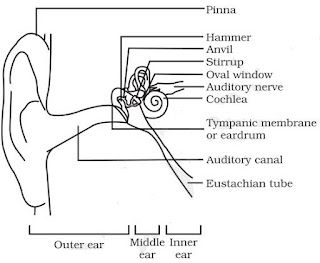
Working of Human ear
Pinna → Ear canal → Ear drum → Hammer → Anvil → Stirrup → Oval window → Cochlea → Audi
nerve → Brain
→ When compression of sound wave strikes the ear drum, the pressure on the outside of ear d
increases and pushes the ear drum inwards.
→ While during rarefaction ear drum moves outwards. Thus, ear drum starts vibrating back an
forth.
→ These vibrations are increased by three bones and middle ear transmits these amplified pre
variations received from sound waves to inner ear.
→ In the inner ear the pressure variations are turned into electric signals by the cochlea.
→ These electric signals are sent to the brain via auditory nerve and the brain interprets them
sound.
1. Introduction
- Books Name
- Science Made Easy Science Book
- Publication
- Science Made Easy
- Course
- CBSE Class 9
- Subject
- Science
Introduction
→ The sensation felt by our ears is called sound.
→ Sound is a form of energy which makes us hear.
→ Law of conservation of energy is also applicable to sound.
→ Sound travels in form of wave.

Production of Sound
→ Sound is produced when object vibrates or sound is produced by vibrating objects.
→ The energy required to make an object vibrate and produce sound is provided by some out
source (like our hand, wind etc.).
→ Example: Sound of our voice is produced by vibration of two vocal cords in our throat.
• Sound of a drum or tabla is produced by vibration of its membrane
when struck.
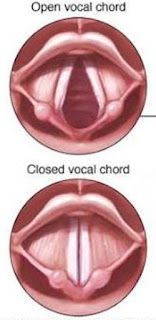
→ In laboratory experiments, sound is produced by vibrating tuning fork. The vibrations of tuning fork
can be shown by touching a small suspended pith ball (cork ball) with a prong of the sounding
tuning fork. The pith ball is pushed away with a great force.
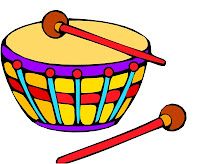
→ In laboratory experiments, sound is produced by vibrating tuning fork. The vibrations of tuning fork
can be shown by touching a small suspended pith ball (cork ball) with a prong of the sounding
tuning fork. The pith ball is pushed away with a great force.
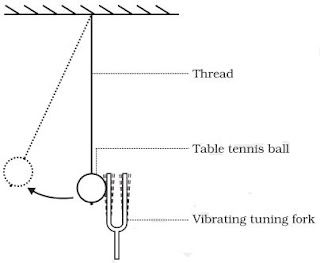
• Sound can be produced by following methods:
(i) By vibrating string (sitar)
(ii) By vibrating air (flute)
(iii) By vibrating membrane (table, drum)
(iv) By vibrating plates (bicycle bell)
(v) By friction in objects
(vi) By scratching or scrubbing the objects etc
1. Introduction
Sound
Introduction
• Sound energy is a form of energy because of which our ears are able to hear something.
• One cannot create sound or destroy it. But one can transform one form of energy into sound energy. For instance, when a cell phone rings, the sound is produced by converting electrical energy into sound energy.
• A wave that is produced when objects of the medium oscillate is called Mechanical Wave. The sound waves are therefore, mechanical waves.
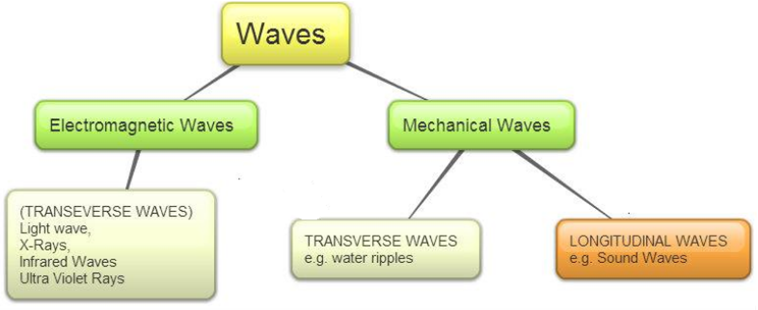
Types of Waves
• Sound cannot travel through the vacuum as it always needs a medium to propagate. The vacuum contains no air hence no particles can propagate sound.
Longitudinal waves - Any wave that vibrates in the direction of the motion is called a Longitudinal Wave. Sound waves are longitudinal because the particles of the medium vibrate in the direction which is parallel to the direction of the propagation of the sound waves. The particles in the medium oscillate to and fro in the case of longitudinal waves.
Transverse Waves - A transverse wave is produced when the particles of the medium oscillate in a direction which is perpendicular to the direction of the propagation of the wave. The particles in a transverse wave oscillate in an up and down motion. For Example, light waves are transverse in nature.
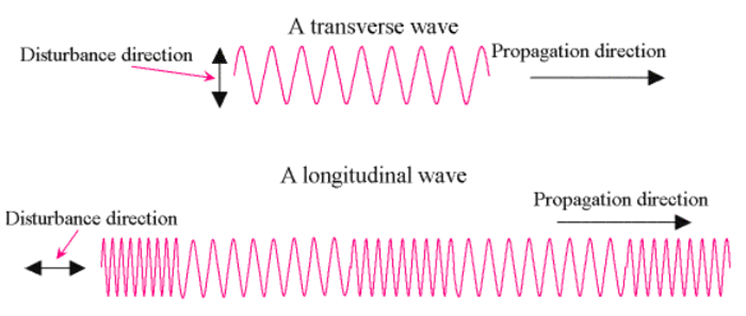
PRODUCTION OF SOUND
- Books Name
- Science Made Easy Science Book
- Publication
- Science Made Easy
- Course
- CBSE Class 9
- Subject
- Science
Production of Sound
→ Sound is produced when object vibrates or sound is produced by vibrating objects.
→ The energy required to make an object vibrate and produce sound is provided by some out
source (like our hand, wind etc.).
→ Example: Sound of our voice is produced by vibration of two vocal cords in our throat.
• Sound of a drum or tabla is produced by vibration of its membrane
when struck.
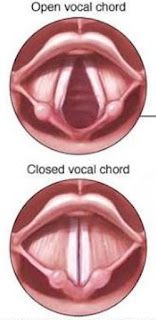
→ In laboratory experiments, sound is produced by vibrating tuning fork. The vibrations of tuning fork
can be shown by touching a small suspended pith ball (cork ball) with a prong of the sounding
tuning fork. The pith ball is pushed away with a great force.
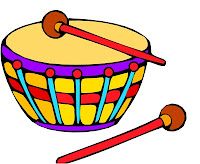
→ In laboratory experiments, sound is produced by vibrating tuning fork. The vibrations of tuning fork
can be shown by touching a small suspended pith ball (cork ball) with a prong of the sounding
tuning fork. The pith ball is pushed away with a great force.
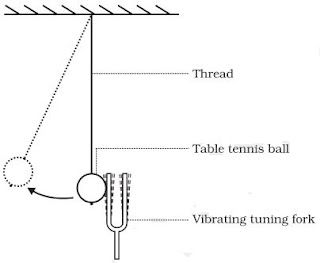
• Sound can be produced by following methods:
(i) By vibrating string (sitar)
(ii) By vibrating air (flute)
(iii) By vibrating membrane (table, drum)
(iv) By vibrating plates (bicycle bell)
(v) By friction in objects
(vi) By scratching or scrubbing the objects etc.
2. Characterstics of Sound
- Books Name
- Science Made Easy Science Book
- Publication
- Science Made Easy
- Course
- CBSE Class 9
- Subject
- Science
Propogation of Sound
→ The substance through which sound travels is called a medium.
→ The medium may be solid, liquid or gas.
→ When an object vibrates, then the air particles around it also start vibrating in exactly the same
way and displaced from their stable position.
→ These vibrating air particles exert a force on nearby air particles so they are also displaced from
their rest position and start to vibrate.
→ This process is continued in the medium till sound reaches our ears.
→ The disturbance produced by sound travels through the medium (not the particles of the
medium).
→ Wave is a disturbance which travels through a medium and carries energy.
→ So sound travels in wave form known as mechanical waves.

• When a body vibrates then it compresses the air surrounding it and form a area of high density
called compression (C).
→ Compression is the part of wave in which particles of the medium are closer to one another
forming high pressure.
→ This compression move away from the vibrating body.
• When vibrating body vibrates back a area of low pressure is formed called rarefaction (R).
→ Rarefaction is the area of wave in which particles of the medium are further apart from one
another forming a low pressure or low density area.
→ When body vibrates back and forth, a series of compression and rarefaction is formed in air
resulting in sound wave.
→ Propogation of sound wave is propogation of density change.
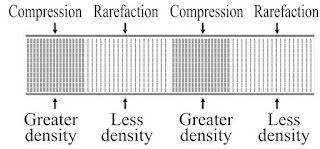
Sound needs Medium for Propogation
• Sound waves are mechanical waves.
→ It needs material medium for propogation like air, water, steel etc.
→ It cannot travel in vaccum.
→ An electric bell is suspended in airtight bell jar connected with vacuum pump.
→ So, medium is necessary for propagation of sound.
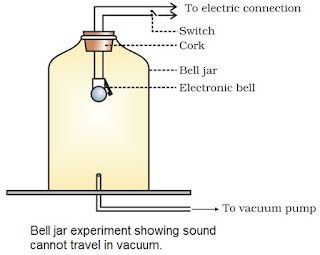
Experiment to show that sound cannot travel through vacuum
2. Characterstics of Sound
Characteristics of Sound
A sound wave is characterized by three factors:
• Amplitude
• Frequency
• Speed
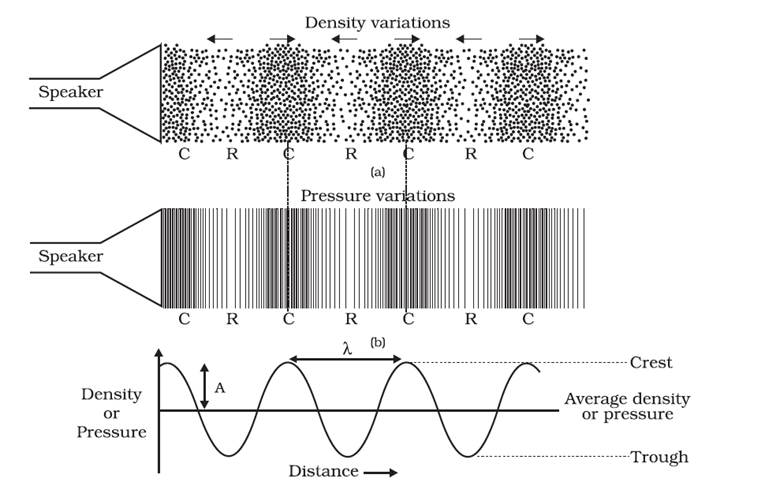
Sound cannot travel at the same speed in different mediums. The speed of sound in a medium is affected by three things:
• The density of the medium. For instance, speed of sound is the maximum through solids
• The temperature of the medium. As the temperature increases, the sound propagates easily.
• Humidity in the air also affects the travel of sound. As the humidity increases, so does the propagation of sound.
Properties of Sound Waves:
Frequency: Number of oscillations of sound waves is called its frequency. The number of peak and troughs per unit of time will give frequency. It is represented by v (nu) and its SI unit is Hertz (Hz).
Time Period: The time taken to complete one oscillation is called its time period. Its unit is second and is represented by T.
Relation of frequency and time period:
v = 1/T
Amplitude: The magnitude of the maximum disturbance in the medium on either side of the mean value is called the amplitude of the wave. It is usually represented by the letter A. Its unit is meter. Softness or Loudness of Sound: If the amplitude is smaller than the sound will be softer and if it is larger than sound will be louder. Higher amplitude helps the sound wave is travelling faster.
Sonic Booms
• When an object travels in the air with a speed greater than that of the sound, it produces a sound with high energy.
• This energy is loud enough that it can break glasses or damage the buildings. The sound produced is similar to the sound of an explosion or thunderclap.
• These objects exert a large amount of pressure on the air which causes the production of shock waves in the air.
• These shock waves produce extremely large and loud sound waves which are called Sonic booms.
• Speed of light in air = 3 * 108 m/s
• Speed of sound in air = 344 m/s
This clearly states that sound travels a lower speed than that of light in air. This is a reason why at the time of lightening, the light is visible instantly while the sound of the thunder reaches our ears after a few seconds.
3. Reflection of Sound and Its Applications
- Books Name
- Science Made Easy Science Book
- Publication
- Science Made Easy
- Course
- CBSE Class 9
- Subject
- Science
Sound Waves as Longitudinal Waves
• A wave in which the particles of the medium vibrate back and forth in the same direction in which
the wave is moving, is called a longitudinal wave.
→ When we push and pull the slinky compression (number of turns are more or closer) and
rarefaction (number of turns are less or farther) are formed.
→ When a wave travels along with slinky, its each turn moves back and forth by only a small
distance in the direction of wave. So the wave is longitudinal.
→ The direction of vibrations of the particles is parallel to the direction of wave.

• When one end of a slinky is moved up and down rapidly whose other end is fixed, it produces
transverse wave.
→ This wave possess along the slinky in horizontal direction, while turns of slinky (particles) vibrates
up and down at right angle to the direction of wave.
→ Thus in transverse wave particles of the medium vibrate up and down at right angles to the
direction of wave.
→ Light waves are transverse waves but they don’t need a material

3. Reflection of Sound and Its Applications
Laws of reflection
• The incident sound wave, the reflected sound wave and the normal, all lie in the same plane.
• The angle of incident of incident sound wave is equal to the angle of reflection formed by the reflected sound wave, that is, i = r
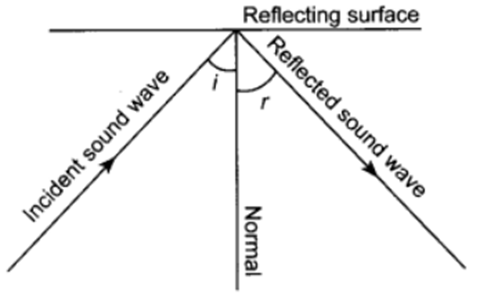
Echo
• When we hear the same sound again and again in a medium it is called Echo.
• The sound or echo persists in our brain for 0.1 seconds. This means that the difference between sound and its echo should be at least 0.1 seconds.
• It is produced as a result of reflection of sound through a medium. If sound reflects more than once we may hear multiple echoes.
Reverberation: Repeated reflections of sound results in persistence of sound and is called reverberation.
Use of Reverberation of Sound: Following instruments use this property of sound:
1. Megaphones, Shehanais, Trumpets
2. Stethoscope
3. Curved dome of concert halls
Advantages of Multiple Reflection of Sound
• Horns, trumpets, loudhailers or megaphones are designed in such a way that sound can travel in a particular direction only without spreading out everywhere. This makes it easier for the audience to listen to the speaker. All these instruments work on the phenomena of multiple reflections of sound.
• The multiple reflections in a stethoscope tube make it possible for the doctors to listen to a patient’s heartbeat.
• Concert halls are generally covered so that sound can reflect through it and reach the wider audience.
• Human auditory range is between 20 Hz and 20000 Hz.
4. Ultrasound's and its Application
- Books Name
- Science Made Easy Science Book
- Publication
- Science Made Easy
- Course
- CBSE Class 9
- Subject
- Science
Characteristics of Sound Wave
• The characteristics of sound waves are : wavelength, frequency, amplitude, time period and
velocity.
→ When a wave travel in air the density and pressure of air changes from their mean position.
→ Compression is shown by crest while rarefaction is shown by trough.
→ Compression is the region of maximum density or pressure.
→ Rarefaction is the region of minimum density or pressure.
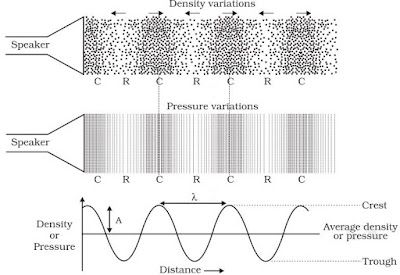
Wavelength
→ In sound waves the combined length of a compression and an adjacent rarefaction is called
wavelength.
→ The distance between the centres of two consecutive compressions or two consecutive
rarefactions is also called its wavelength.
→ It is denoted by the Greek letter lamda (λ). Its SI unit is metre.
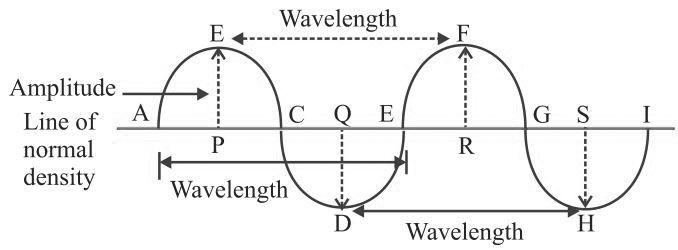
Frequency
→ No. of complete waves produced in one second or number of vibrations per second is called
frequency.
→ Number of compressions or rarefactions passed in one second is also frequency.
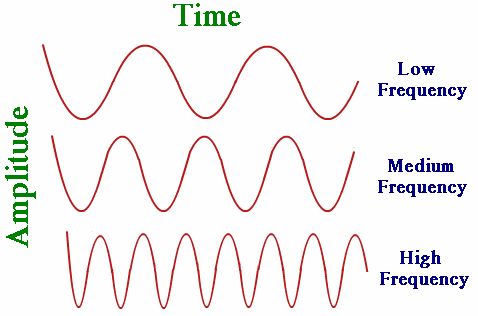
→ Frequency of wave is same as the frequency of the vibrating body which produces the wave
• The SI unit of frequency is hertz (Hz). The symbol of frequency is v (nu).
• 1 Hertz: One Hz is equal to 1 vibration per second.
• Bigger unit of frequency is kilohertz kHz = 1000 Hz.
Time Period
→ Time taken to complete one vibration is called time period.
→ Time required to pass two consecutive compressions or rarefactions through a point is called
time period.
• SI unit of time period is second (s). Time period is denoted by T.
• The frequency of a wave is the reciprocal of the time period.
• v = 1/T
Amplitude
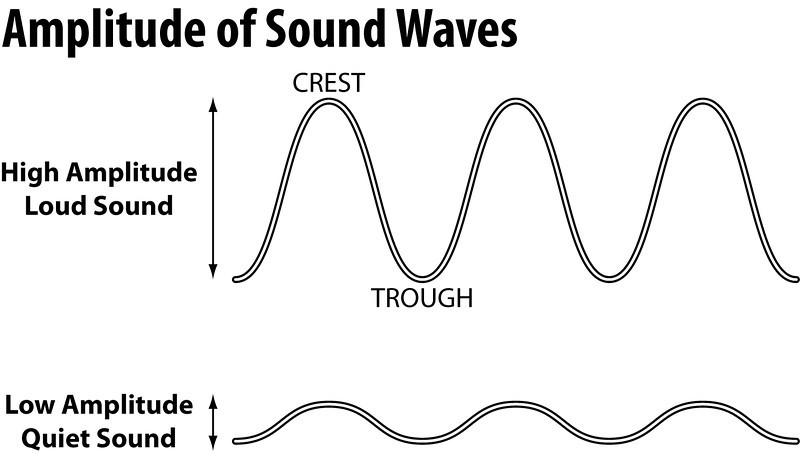
→ The maximum displacement of the particle of the medium from their original undisturbed
position is called amplitude of the wave.
• Amplitude is denoted by A and its SI unit is metre (m).
→ Sound have characteristics like pitch and loudness and timbre.
• Pitch: The pitch of sound depends on the frequency of sound (vibration).
→ It is directly proportional to its frequency. Greater the frequency, higher is the pitch and lesser the
frequency, lower is the pitch.
→ A woman’s voice is shrill having a high pitch while a man’s voice is flat having low pitch.
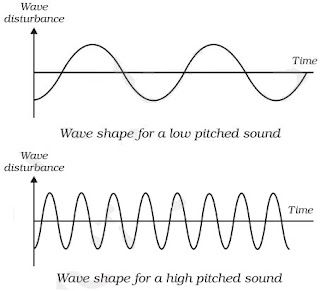
• Loudness: The loudness depends on the amplitude of the sound wave.
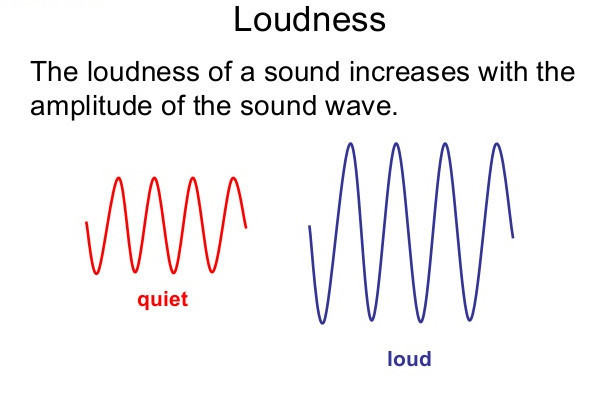
→ Loudness is the measure of the sound energy reaching the ear per sec.
→ Greater the amplitude of sound wave, greater is the energy, louder the sound; short is the
amplitude, less is the energy, soft is the sound.
→ Loudness is measured in decibel ‘dB’.
• Quality or Timbre: The timbre of a sound depends on the shape of sound wave produced by
the characteristic of musical sound.
→ It helps us to distinguish between two sounds of same pitch & loudness.
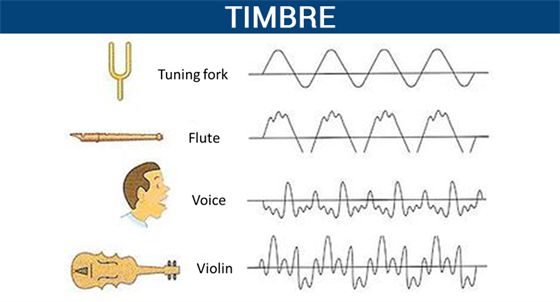
• Sound of single (same) frequency is called tone while a mixture of different frequencies is called
note.
• The distance travelled by a wave in one second is called velocity of the wave.
• Its SI unit is metre per second (m/s ).
Velocity = Distance travelled/Time taken
⇒ v = λ/T
(λ is the wavelength of the waves travelled in one time time period T)
v = λv (1/T = v)
So, Velocity = Wavelength × Frequency
This is the wave equation.
Example: What is the frequency of sound wave whose time period is 0.05 second ?
4. Ultrasound's and its Application
Ultra Sound
The ultrasound waves are the sound waves with high frequency. Due to this, they can travel long distances despite any obstacles between their paths.
Application of Ultra Sound
• The ultrasound waves are used in clearing parts of objects that are hard to reach such as a spiral tube or electronic components. In order to clean the objects, they are put in a solution, then the ultrasonic waves are passed through the solution. As a result, the dust particles on the object get detached and fall off them.
• Ultrasound waves can recognize tiny cracks in metallic objects that are used in the manufacture of large structures, buildings and scientific equipment. The presence of such cracks can lower the strength of these structures and machines. Hence, the ultrasound waves are passed through the metallic objects and detectors are used to detect the waves that pass through the cracks. If a crack is present the ultrasound waves would reflect back.
• Ultrasonic waves are also used in a medical process called Echocardiography. In this process, the ultrasound waves are passed through various parts of the heart in order to form the images of the organ.
• Ultrasonic waves are also used in a procedure called Ultrasonography. In this procedure, the ultrasonic waves are passed through the internal organs of the body in order to get their image. In this way, the doctors can find out the cause of a disease or any abnormalities in the organs. The ultrasound waves travel through the tissues of the body and as soon as the density of the tissue changes, they reflect back. The reflected waves are then converted into electrical signals which form the images of the internal organs.
• Ultrasound waves are also used to break the kidney stones.
SONAR – Sound Navigation and Ranging
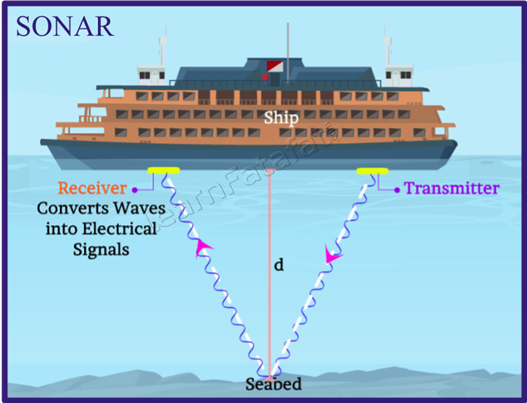
• This device is used to find the distance, direction and speed of objects that are present under the water. It uses Ultrasonic waves to do so.
• The Sonar consists of two main devices – The transmitter and the detector (or receiver). The main function of the transmitter is the production and transmission of the Ultrasonic waves in water.
• As these waves travel underwater, they, when hit by an object, reflect back to the detector. The detector then converts these sound waves into electrical signals which are then interpreted.
• The distance of the object is calculated with the help of the speed of sound in water and time taken by the way to reach the detector. This process is called Echo Ranging.
Uses of Sonar
• Finding the depth of a water body such as sea
• Detecting the presence of underwater objects like submarines, hills, icebergs and ships
The Human Ear
The ear is a sensitive organ of the human body. It is mainly involved with detecting, transmitting and transducing sound and maintaining a sense of balance is another important function of the human ear. Human ear includes:
• The outer ear or the visible part of the ear is called the pinna.
• Pinna collects sound from the surroundings.
• Sound passes through a tube called an auditory canal.
• Eardrum (tympanic membrane) vibrates in response to incident sound waves.
• Vibrations are amplified and transmitted further by three bones hammer, anvil and stirrup in the middle ear to the inner ear.
• In the inner ear, cochlea converts pressure signals into electrical signals.
• Electrical signals are transmitted by the auditory nerve to the brain for interpretation.
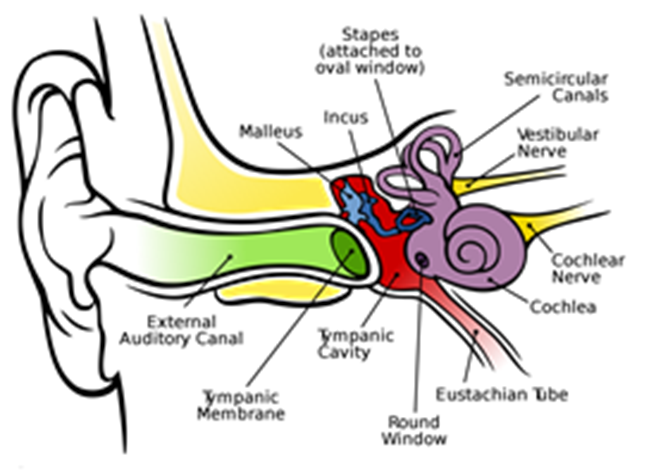
Structure of Human Ear
5. Applications Of Ultrasound
- Books Name
- Science Made Easy Science Book
- Publication
- Science Made Easy
- Course
- CBSE Class 9
- Subject
- Science
Speed of Sound in Various Mediums
→ Speed of sound depends on the nature of material through which it travels. It is slowest in gases,
faster in liquids and fastest in solids.
→ Speed of sound increases with the rise in temperature.
→ Speed of sound increases as humidity of air increases.
→ Speed of light is faster than speed of sound.
→ In air, speed of sound is 344 ms-1 at 22ºC.
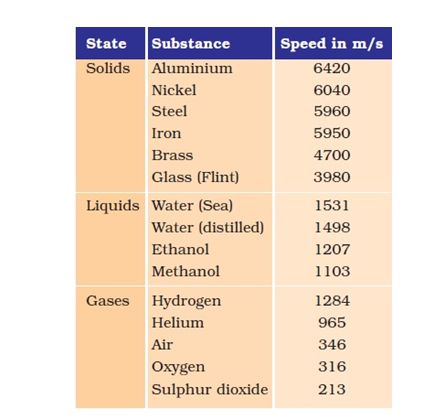
Sonic Boom
→ Some aircrafts, bullets, rockets etc. have ‘supersonic speed’.
• Supersonic refers to the speed of an object which is greater than the speed of sound and it
produces extremely loud sound waves called ‘shock waves’ in air.
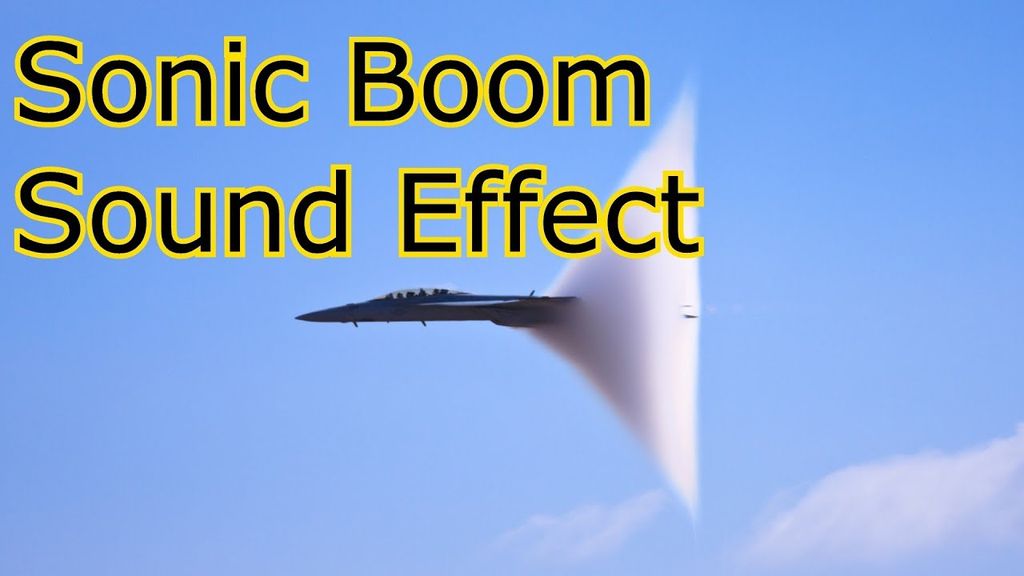
Reflection of Sound
→ Like light, sound also bounce back when it falls on a hard surface. It is called reflection of sound.
• The laws of reflection of light are obeyed during reflection of sound.
(i) The incident sound wave, the reflected sound wave and normal at the point of incidence lie
same plane.
(ii) Angle of reflection of sound is always equal to the angle of incidence of sound.
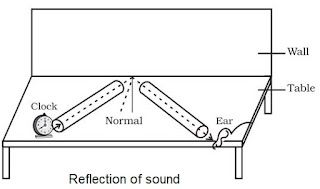
SONIC BOOM
- Books Name
- Science Made Easy Science Book
- Publication
- Science Made Easy
- Course
- CBSE Class 9
- Subject
- Science
Sonic Boom
→ Some aircrafts, bullets, rockets etc. have ‘supersonic speed’.
• Supersonic refers to the speed of an object which is greater than the speed of sound and it
produces extremely loud sound waves called ‘shock waves’ in air.

REFLECTION OF SOUND
- Books Name
- Science Made Easy Science Book
- Publication
- Science Made Easy
- Course
- CBSE Class 9
- Subject
- Science
Reflection of Sound
→ Like light, sound also bounce back when it falls on a hard surface. It is called reflection of sound.
• The laws of reflection of light are obeyed during reflection of sound.
(i) The incident sound wave, the reflected sound wave and normal at the point of incidence lie
same plane.
(ii) Angle of reflection of sound is always equal to the angle of incidence of sound.

6. Structure Of Human Ear
- Books Name
- Science Made Easy Science Book
- Publication
- Science Made Easy
- Course
- CBSE Class 9
- Subject
- Science
Echo
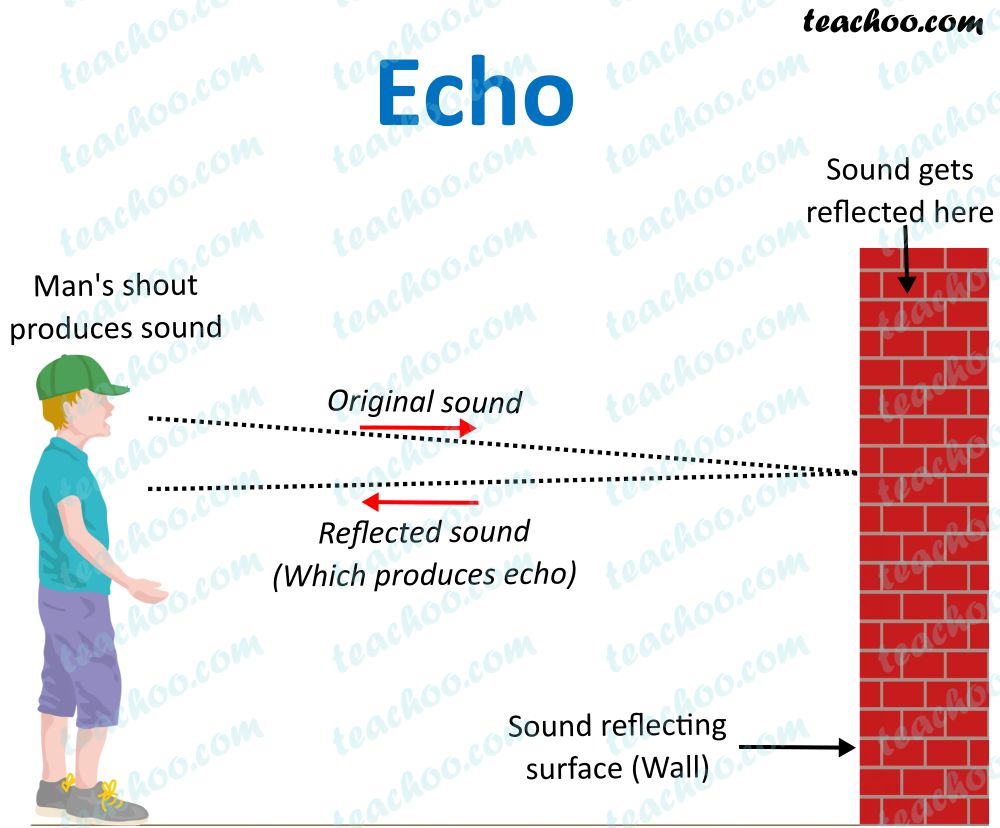
• The repetition of sound caused by the reflection of sound waves is called an echo.
→ We can hear echo when there is a time gap of 0.1 second in original sound and echo (reflection of
sound).
→ Echo is produced when sound reflected from a hard surface (i.e. brick wall, mountain etc.) as
surface tends to absorb sound.
Minimum distance to hear an echo
Speed = Distance/Time
Here, Speed of sound in air = 344 ms -1 at 22ºC
Time = 0.1 second
344 = Distance/0.1 sec
⇒ Distance = 344 × 0.1 = 34.4 m
So, distance between reflecting surface and audience = 34.4/2 = 17.2 (at 22ºC).
Reverberation
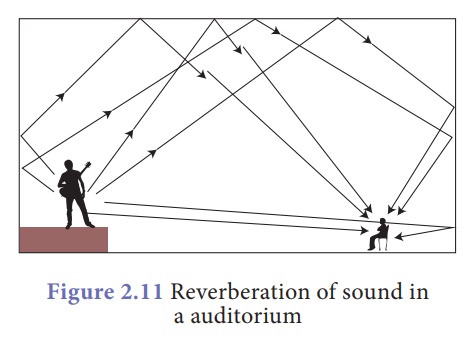
• The persistence of sound in a big hall due to repeated reflection of sound from the walls, ceiling
and floor of the hall is called reverberation.
→ If reverberation is too long, sound becomes blurred, distorted and confusing due to overlapping
of different sound.
Methods to reduce reverberation in big halls or auditoriums
→ Panels made of felt or compressed fibre board are put on walls and ceiling to absorb sound
→ Heavy curtains are put on doors and windows.
→ Carpets are put on the floor.
→ Seats are made of material having sound absorbing properties.
APPLICATIONS OF REFLECTION OF SOUND
- Books Name
- Science Made Easy Science Book
- Publication
- Science Made Easy
- Course
- CBSE Class 9
- Subject
- Science
Applications of Reflection of Sound
(i) Megaphone, loudspeakers, bulb horns and trumpets, shehnai etc. are designed to send sound to
a particular direction without spreading all around.
→ All these instruments have funnel tube which reflects sound waves repeatedly towards audio
In this amplitude of sound waves adds up to increase loudness of sound.
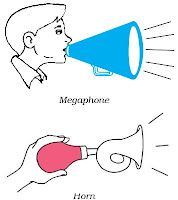
(ii) Stethoscope: It is a medical instrument used for listening the sounds produced in human bo
mainly in heart and lungs. The sound of the heartbeats reaches the doctor’s ears by the multipe
reflection of the sound waves in the rubber tube of stethoscope.

(iii) Sound Board: In big halls or auditoriums sound is absorbed by walls, ceiling, seats etc. So a
curved board (sound board) is placed behind the speakers so that his speech can be heard ea
by audiences. The soundboard works on the multiple reflection of sound.
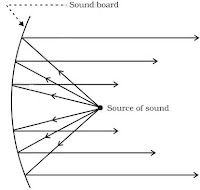
(iv) The ceiling of concert halls are made curved, so that sound after reflection from ceiling, rea
all the parts of the hall.
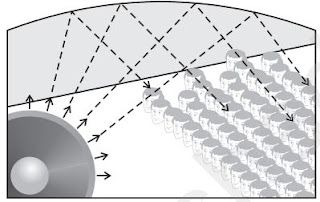
RANGE OF HEARING
- Books Name
- Science Made Easy Science Book
- Publication
- Science Made Easy
- Course
- CBSE Class 9
- Subject
- Science
Range of Hearing
(i) Range of hearing in human is 20 Hz to 20000 Hz.
→ Children younger than 5 years and dogs can hear upto 25 Khz.
(ii) The sounds of frequencies lower than 20 Hz are
known as ‘infrasonic sounds’
→ A vibrating simple pendulum produces infrasonic sounds.
→ Rhinoceroses communicate each other using frequencies as low as 5 Hz.
→ Elephants and whales produces infrasonic waves.
→ Earthquakes produces infrasonic waves (before shock waves)
which some animals can hear and get disturbed.
(iii) The sounds of frequencies higher than 20 KHz are known as ‘ultrasonic waves’.
→ Dogs, parpoises, dolphins, bats and rats can hear ultrasonic sounds.
→ Bats and rats can produce ultrasonic sounds.
Hearing Aid
→ It is battery operated electronic device used by persons who are hard of hearing.
→ Microphone convert sound into electrical signals, than those are amplified by amplifier. Ampified
signals are send to the speaker of hearing aid. The speaker converts the amplified signal to sound
and sends to ear for clear hearing.
Applications of Ultrasound
(i) It is used to detect cracks in metal blocks in industries without damaging them.
(ii) It is used in industries to clean ‘hard to reach’ parts of objects such as spiral tubes, odd shaped
machines etc.
(iii) It is used to investigate the internal organs of human body such as liver, gall bladder, kidney
uterus and heart.
(iv) Ecocardiography: These waves are used to reflect the action of heart and its images are
formed. This technique is called echocardiography.
(v) Ultrasonography: The technique of obtaining pictures of internal organs of the body by using
echoes of ultrasound waves is called ultrasonography.
(vi) Ultrasound is used to split tiny stones in kidneys into fine grains.
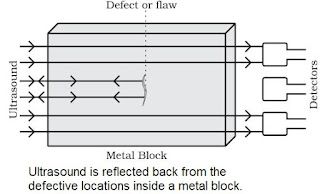
SONAR
→ The word ‘SONAR’ stands for ‘Sound Navigation And Ranging’.
→ SONAR is a device which is used to find distance, direction and speed of underwater objects
→ SONAR consists of a transmitter and a receptor or detector and installed at the bottom of a sea
→ The transmitter produces and transmits ultrasonic waves.
→ These waves travel through water and after striking the objects on the bottom of sea, are
reflected back and received by detector.
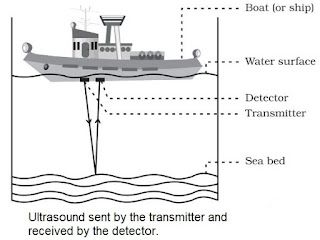
→ These reflected waves are converted into electric signals by detector.
→ The sonar device measures the time taken by ultrasound waves to travel from ship to bottom of
sea and back to ship.
→ Half of this time gives the time taken by the ultrasound waves from ship to bottom.
• Let the time interval between transmission and reception of ultrasound signal is t.
Speed of sound through sea water is v
Total distance travelled by waves = 2d.
→ The sonar is used to find the depth of sea, to locate underwater hills, valleys, submarines, ice
and sunken ships etc.
→ Bats fly in the dark night by emitting high pitched ultrasound waves which are reflected from
obstacle or prey and returned to bats ear.
→ The nature of reflection tells the bat where the obstacle or prey is and what it is like.
HUMAN EAR
- Books Name
- Science Made Easy Science Book
- Publication
- Science Made Easy
- Course
- CBSE Class 9
- Subject
- Science
Structure of Human Ear
→ The ear consists of three parts: outer ear, middle ear and inner ear.
→ The ears are the sense organs which help us in hearing sound.
→ The outer ear is called pinna. It collects the sound from surroundings.
→ This sound passes through the auditory canal.
→ At the end of auditory canal, is a thin elastic membrane called ear drum or tympanic memb
→ The middle ear contains of three bones: hammer, anvil and stirrup linked with one another. F
end of hammer touches ear drum and that of stirrup linked with membrane of oval window of
ear.
→ The lower part of middle ear has a narrow ‘Eustachian tube’.
→ The inner ear has a coiled tube called cochlea, which is connected with oval window. Cochle
filled with a liquid containing nerve cells.
→ Other side of cochlea is connected to auditory nerve which goes to brain.
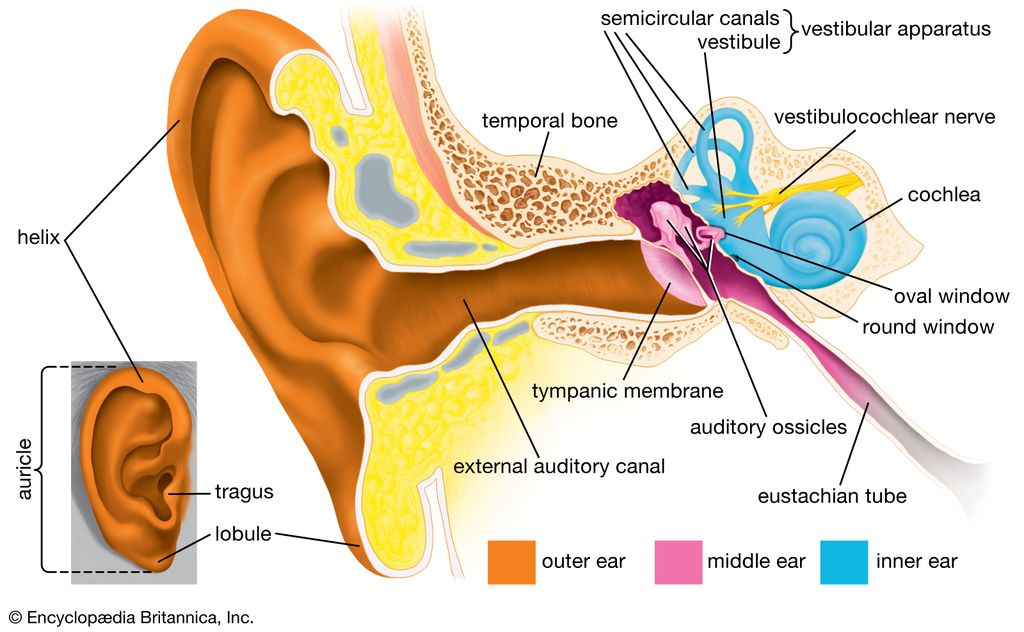
Working of Human ear
Pinna → Ear canal → Ear drum → Hammer → Anvil → Stirrup → Oval window → Cochlea → Audi
nerve → Brain
→ When compression of sound wave strikes the ear drum, the pressure on the outside of ear d
increases and pushes the ear drum inwards.
→ While during rarefaction ear drum moves outwards. Thus, ear drum starts vibrating back an
forth.
→ These vibrations are increased by three bones and middle ear transmits these amplified pre
variations received from sound waves to inner ear.
→ In the inner ear the pressure variations are turned into electric signals by the cochlea.
→ These electric signals are sent to the brain via auditory nerve and the brain interprets them
sound.

 Science Made Easy
Science Made Easy
